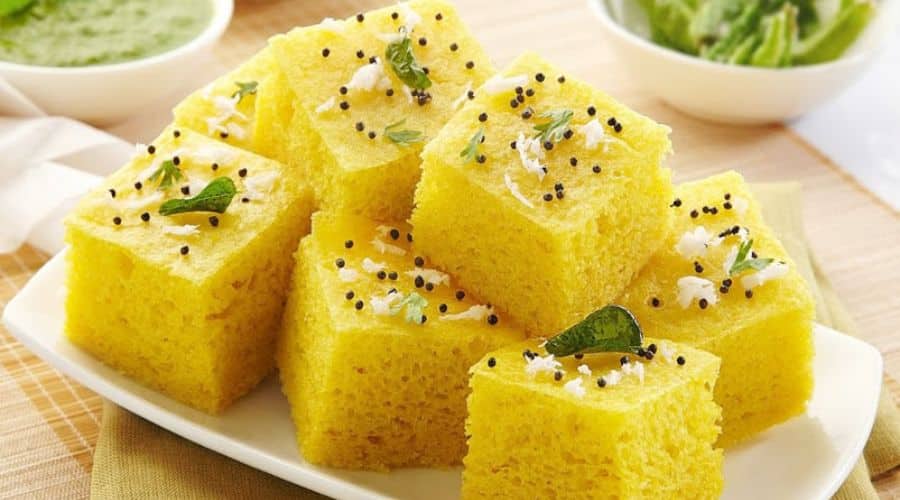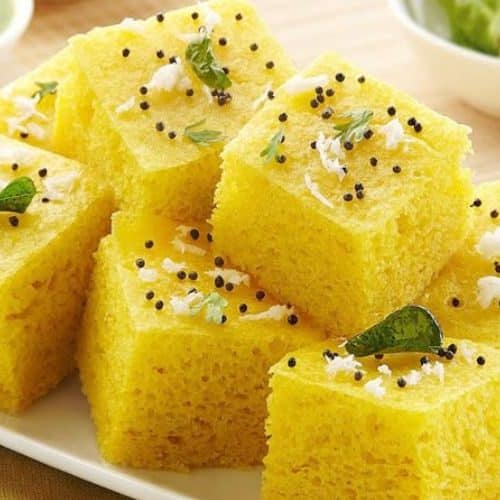Khaman is a beloved snack from Gujarat, known for its soft, fluffy texture and mildly spiced flavor.
Often enjoyed with chutneys or as part of a larger meal, this steamed dish is a favorite among people of all ages.
Whether you’re hosting a gathering, craving a savory treat, or exploring the rich diversity of Indian cuisine, Khaman serves as the perfect addition to your culinary repertoire.
This easy-to-follow recipe will guide you through the process of making Khaman, from selecting the right ingredients to mastering the cooking technique that gives it that perfect texture.

What is Khaman?
Khaman is a savory steamed cake made from chickpea flour (besan), and it’s a popular dish in Gujarati households.
This light and fluffy snack has a golden-yellow color and is typically garnished with mustard seeds, curry leaves, and a drizzle of tangy sugar syrup.
Khaman has a distinctive texture that’s spongy yet moist, making it different from other steamed dishes like Dhokla.
Although Khaman and Dhokla share many similarities, Khaman is typically finer in texture and often spicier than Dhokla.
It is often served at breakfast, as a snack, or even as a side dish at festive gatherings.
Its versatility and vibrant flavors make it a beloved dish across India and beyond.
Key Ingredients for Khaman
To create the perfect Khaman, you’ll need to gather a few key ingredients that are easy to find at local grocery stores or Indian markets. Here’s what you’ll need:
- Chickpea Flour (Besan): The base of Khaman, chickpea flour gives the dish its texture and nutty flavor.
- Yogurt: This helps in fermenting the batter and provides a soft texture to the dish.
- Turmeric: This adds a subtle earthiness and the iconic yellow color to Khaman.
- Baking Soda: To make the Khaman light and fluffy, baking soda is essential.
- Mustard Seeds and Cumin Seeds: These are used for tempering, which adds a burst of flavor to the dish.
- Sugar: A small amount of sugar balances the savory flavor and adds a hint of sweetness to the Khaman.
- Curry Leaves and Green Chilies: These bring a fragrant and slightly spicy kick to the dish.
- Ginger and Asafoetida (Hing): These ingredients enhance the flavor with their aromatic profiles.
- Salt: Essential to bring out the flavors of the dish.
How to Prepare Khaman: Step-by-Step Guide

Making Khaman requires a few simple steps, but with patience and attention to detail, you can create a dish that’s as authentic as what you would find in Gujarat.
Step 1: Prepare the Khaman Batter
Start by sifting the chickpea flour (besan) into a mixing bowl. Add turmeric, a pinch of salt, and sugar.
Then, pour in the yogurt and mix well. Gradually add water to the mixture, making sure to stir continuously until you get a smooth batter.
The consistency should be slightly thicker than pancake batter.
Step 2: Add the Leavening Agent
To make the Khaman light and fluffy, dissolve a pinch of baking soda in a small amount of water.
Add this to the batter just before you’re ready to steam. Stir gently to incorporate it into the batter without overmixing.
Step 3: Prepare the Steaming Setup
Take a steaming vessel or a large pot and fill it with water. Bring the water to a boil.
Grease a round or square cake tin with a little oil or ghee to prevent sticking, then pour the prepared batter into the tin.
Level the batter with a spatula to ensure even cooking.
Step 4: Steam the Khaman
Place the tin into the steaming vessel. Cover it with a lid and steam the Khaman for about 15-20 minutes.
To check if it’s done, insert a toothpick into the center of the Khaman – it should come out clean when it’s fully cooked.
Step 5: Tempering (Tadka)
In a separate small pan, heat some oil and add mustard seeds, cumin seeds, green chilies, curry leaves, and ginger.
Let the seeds splutter and the spices release their aroma. Pour this hot tempering over the steamed Khaman, spreading it evenly.
This adds a burst of flavor and fragrance to the dish.
Once the Khaman is fully steamed and the tempering is added, cut it into squares or diamond-shaped pieces.
Serve hot, garnished with fresh coriander leaves and a side of tangy chutney or sweet tamarind sauce.
Tips for Making the Perfect Khaman
Achieving the ideal texture and flavor when making Khaman can take a bit of practice, but with these tips, you’ll be able to make the perfect batch every time:
- Consistency is Key: The batter should not be too runny or too thick. The ideal consistency is similar to that of pancake batter—smooth and pourable but not watery. If it’s too thick, your Khaman may turn out dense. If it’s too runny, it won’t rise properly.
- Don’t Overmix: Once the baking soda or ENO fruit salt is added, avoid overmixing the batter. Stir it gently to prevent deflating the batter, which will affect the fluffiness of the final product.
- Proper Steaming: Ensure that the water in the steamer or pot is boiling before placing the batter inside. Steaming Khaman over high heat allows it to rise and cook evenly. A slow or uneven steam might lead to a soggy texture.
- Use Fresh Ingredients: Fresh yogurt and spices make a significant difference in flavor. Ensure that your baking soda or ENO is within its expiry date, as it’s essential for leavening.
- Check for Doneness: Always perform the toothpick test after 15-20 minutes of steaming. If it comes out clean, your Khaman is ready. If it has some batter sticking, steam it for a few more minutes.
- Add a Little Sugar to the Tadka: While preparing the tempering, a pinch of sugar added to the hot oil can enhance the flavors and give the Khaman a slight sweetness that balances the savory elements.
How to Serve Khaman
Khaman can be served in various ways, depending on the occasion or personal preference.
Here are a few ideas to elevate your Khaman experience:
- With Chutneys: Khaman pairs wonderfully with a variety of chutneys. The most common choices are cilantro-mint chutney, tamarind chutney, or a tangy yogurt dip. The cool, creamy nature of these chutneys complements the warm, spicy Khaman perfectly.
- Garnished with Fresh Herbs: After steaming, garnish your Khaman with freshly chopped coriander or mint leaves to add a burst of color and flavor. You can also sprinkle a little grated coconut on top for added texture.
- As a Breakfast or Snack: Traditionally, Khaman is enjoyed as a breakfast item or a mid-morning snack. It can also serve as a side dish during meals or as part of a larger spread during festive celebrations.
- With Hot Tea or Coffee: Khaman is delicious when paired with a cup of hot masala chai or even black coffee. The warmth of the drink complements the soft, savory Khaman.
- For Special Occasions: You can elevate the dish for parties or celebrations by serving it with a variety of accompaniments like samosas, pakoras, or a colorful salad to balance the flavors. Khaman also pairs well with rice dishes like khichdi or pulav during festive occasions.
Khaman is versatile and can be customized to suit different tastes, making it a perfect dish for both casual meals and grand celebrations.
Variations of Khaman You Can Try
While traditional Khaman is delicious on its own, there are several ways to customize the dish to suit your preferences or to add a unique twist.
Here are some creative variations of Khaman that you can try:
- Sweet and Spicy Khaman: Add a hint of jaggery or sugar to the batter for a subtle sweetness that balances out the spices. This can give your Khaman a delightful contrast between savory and sweet flavors. You can also add a dash of red chili powder for an extra spicy kick.
- Herbed Khaman: For a fragrant, herby version, add finely chopped coriander, mint, or curry leaves directly into the batter before steaming. The fresh herbs infuse the Khaman with an aromatic flavor that makes it even more delicious.
- Cheese Khaman: For a cheesy twist, add grated cheese into the batter, or place a small cube of cheese in the center of each Khaman piece before steaming. The cheese will melt and add a creamy, indulgent element to the dish.
- Vegetable Khaman: Incorporate finely grated vegetables such as carrots, zucchini, or even spinach into the batter. This adds extra nutrition and flavor while keeping the Khaman moist and soft.
- Lemon Khaman: Add a teaspoon of lemon juice to the batter for a zesty, citrusy touch. This will bring a fresh burst of flavor that enhances the overall taste of the Khaman.
- Chili Khaman: If you like it spicy, you can add finely chopped green chilies or a dash of chili powder to the batter. The heat will balance well with the natural sweetness of the sugar syrup that’s typically drizzled on top.
These variations can help you customize your Khaman to suit your taste or to surprise your guests with something new and exciting.
Conclusion
Khaman is a delightful, flavorful, and versatile snack that can easily be prepared at home with just a few ingredients.
Its fluffy texture and savory flavors make it a perfect choice for any occasion—whether as a quick breakfast, a tea-time snack, or part of a festive meal.
With the right ingredients and techniques, you can recreate the authentic taste of Khaman in your own kitchen.
Try experimenting with the variations shared here, and enjoy the endless possibilities this dish offers.
Whether you stick to the classic version or add your twist, Khaman is sure to impress anyone who tastes it!
Frequently Asked Questions (FAQ)
- Can I make Khaman ahead of time? Yes, Khaman can be made a few hours ahead of time. After steaming, allow it to cool and then store it in an airtight container. Reheat it by steaming or microwaving before serving.
- How do I store leftover Khaman? Leftover Khaman can be stored in an airtight container in the refrigerator for up to 2-3 days. Reheat it by steaming or microwaving to restore its softness.
- Can I make Khaman without yogurt? Yes, if you don’t have yogurt, you can use buttermilk or a non-dairy alternative such as coconut yogurt. The yogurt adds moisture and helps with fermentation, so using a substitute with a similar consistency works best.
- Why did my Khaman turn out dense? A dense Khaman is usually the result of a batter that was too thick or insufficiently leavened. Make sure your batter is the right consistency and that you add the baking soda or ENO just before steaming to ensure a fluffy texture.
- Can I make Khaman in a pressure cooker? Yes, you can make Khaman in a pressure cooker by removing the pressure weight and using the cooker as a steamer. Just place the batter in a greased container and steam for about 15-20 minutes on medium heat.

Khaman
Equipment
- Steaming vessel (1) – Large steamer or a pot with a lid
- Cake tin or baking dish (1) – 8-inch round or square tin
- Mixing bowl (1) – For combining ingredients
- Small pan (1) – For tempering the spices
- Spatula (1) – For spreading the batter
- Toothpick (1) – To check for doneness
Ingredients
- Chickpea flour Besan – 1 cup (125g)
- Yogurt – 1/4 cup 60g
- Turmeric powder – 1/4 tsp 1g
- Baking soda – 1/4 tsp 1g
- Sugar – 1 tbsp 15g
- Water – 1/2 cup 120ml (adjust as needed)
- Salt – 1 tsp 5g
- Mustard seeds – 1/2 tsp 2g
- Cumin seeds – 1/2 tsp 2g
- Curry leaves – 6-8 leaves
- Green chilies – 2 finely chopped
- Fresh ginger – 1 tsp 5g, grated
- Asafoetida Hing – a pinch
- Oil or ghee – 1 tsp 5g, for greasing the tin
- Fresh coriander for garnish – 1 tbsp (optional)
Instructions
- Prepare the batter: In a mixing bowl, sift 1 cup of chickpea flour. Add turmeric, salt, and sugar. Mix in yogurt and water gradually, stirring until the batter reaches a smooth, slightly thick consistency (like pancake batter).
- Activate the baking soda: Just before steaming, dissolve the baking soda in a little water and add it to the batter. Mix gently without over-mixing to preserve the fluffiness.
- Prepare the steamer: Fill a large pot or steamer with water and bring it to a boil. Grease the cake tin with a little oil or ghee.
- Steam the batter: Pour the prepared batter into the greased tin and level it out with a spatula. Place the tin into the steamer, cover with a lid, and steam for 15-20 minutes. Check for doneness by inserting a toothpick – it should come out clean when the Khaman is fully cooked.
- Prepare the tempering: While the Khaman is steaming, heat 1 tsp oil in a small pan over medium heat. Add mustard seeds, cumin seeds, curry leaves, green chilies, ginger, and a pinch of asafoetida. Let the seeds splutter, then pour this tempering over the steamed Khaman.
- Garnish and serve: Once the Khaman is steamed and tempered, cut it into squares or diamonds. Garnish with fresh coriander if desired and serve hot with chutneys or as a snack.
Notes
- For a fluffier Khaman, ensure that the batter is not too thick. You can add a bit more water if needed to get the right consistency.
- Tempering: If you prefer a spicier Khaman, you can add extra green chilies or chili powder to the tempering for an added kick.
- Storage: Khaman can be stored in the refrigerator for up to 2-3 days. Reheat by steaming or microwaving for a fresh taste.

